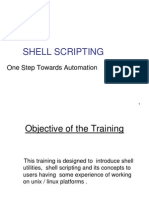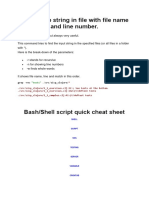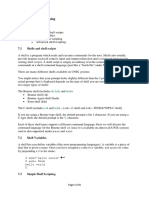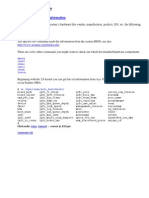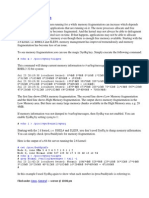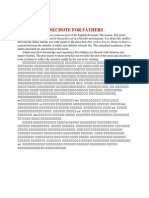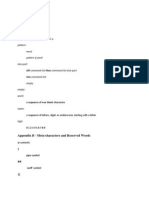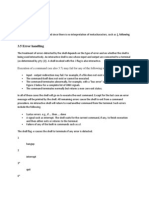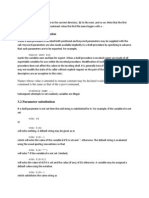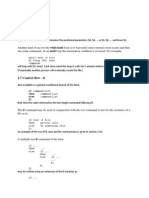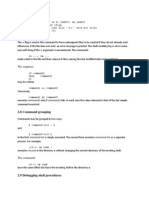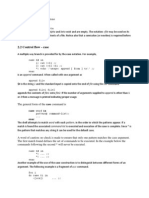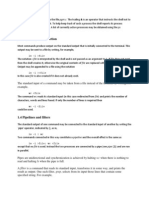6 Examples: 6.1 A Shell Script For Deleting Files
Uploaded by
arunabhatla6 Examples: 6.1 A Shell Script For Deleting Files
Uploaded by
arunabhatlacase string1: commandlist1 breaksw case string2: commandlist2 breaksw default commandlist endsw
The given string str is successively matched against the case patterns. Control flow is switched to where the first match occurs. As in file name expansion, a case label may be a literal string, or contain variable substitution, or contain wild-card character such as *,?, etc. 5. Goto The goto command provides a way to branch unconditionally to a line identified by a label.
goto lab
where lab is a label on a line (by itself) somewhere in the script in the form
lab:
6 Examples
6.1 A Shell Script For Deleting Files
This code, which we will call Del, will delete files like rm does, prompting for your confirmation for each file to be deleted, including directory files (which the -i option of rm won't do).
#! /bin/csh -f foreach name ($argv) if ( -f $name ) then echo -n "delete the file '${name}' (y/n/q)?" else echo -n "delete the entire directory '${name}' (y/n/q)? " endif set ans = $< switch ($ans) case n: continue case q: exit case y: rm -r $name
continue endsw end
(Before reading further, try this program yourself. Set up a test directory, with several files in it, at least one of which is a subdirectory, with at least one file there. Then type `Del *'.)
You might also like
- Unix Shell Scripts: 2.1 Direct InterpretationNo ratings yetUnix Shell Scripts: 2.1 Direct Interpretation8 pages
- Unix Shell Scripting Chapter - 1: List Files That Begin With A Lowercase Letter and Don't End With A DigitNo ratings yetUnix Shell Scripting Chapter - 1: List Files That Begin With A Lowercase Letter and Don't End With A Digit10 pages
- UNIX Operating Systems II Part 2: Shell Scripting: Instructor: Stan IsaacsNo ratings yetUNIX Operating Systems II Part 2: Shell Scripting: Instructor: Stan Isaacs30 pages
- Introduction To UNIX: Lecture Eight: 8.1 ObjectivesNo ratings yetIntroduction To UNIX: Lecture Eight: 8.1 Objectives9 pages
- Lecture Notes: Shell Programming: KSH CSH SH If While ForNo ratings yetLecture Notes: Shell Programming: KSH CSH SH If While For14 pages
- Bourne Shell Programming An IntroductionNo ratings yetBourne Shell Programming An Introduction30 pages
- Bash, Grep String in File With File Name and Line Number.: "Tests"No ratings yetBash, Grep String in File With File Name and Line Number.: "Tests"3 pages
- Ebooks File Shell Programming in Unix Linux and OS X Stephen G. Kochan All Chapters100% (4)Ebooks File Shell Programming in Unix Linux and OS X Stephen G. Kochan All Chapters62 pages
- Shells and Shell Scripts: COMP 444/5201 Revision 1.3 January 25, 2005No ratings yetShells and Shell Scripts: COMP 444/5201 Revision 1.3 January 25, 200534 pages
- Introduction To Shell Programming: Mike Kupferschmid Scientific Programming Consultant VCC 322, x6558, Kupfem@rpi - EduNo ratings yetIntroduction To Shell Programming: Mike Kupferschmid Scientific Programming Consultant VCC 322, x6558, Kupfem@rpi - Edu35 pages
- Command Line - Cheatsheet: S.N Purpose CommandNo ratings yetCommand Line - Cheatsheet: S.N Purpose Command10 pages
- Acknowledgements: Item: Word Input-Output Name Value Simple-Command: Item Simple-Command Item Command: Simple-CommandNo ratings yetAcknowledgements: Item: Word Input-Output Name Value Simple-Command: Item Simple-Command Item Command: Simple-Command2 pages
- September 10, 2007: Linux Hints, Tips, and TricksNo ratings yetSeptember 10, 2007: Linux Hints, Tips, and Tricks1 page
- Apms Recruitment 2012 Roster Wise List of Candidates Allotted TGT - Zone Vi (Venue: Govt. Mahaboobia High School (Girls), Gunfoundry, Hyderbad)No ratings yetApms Recruitment 2012 Roster Wise List of Candidates Allotted TGT - Zone Vi (Venue: Govt. Mahaboobia High School (Girls), Gunfoundry, Hyderbad)12 pages
- September 2, 2007: Simple Network Performance TestNo ratings yetSeptember 2, 2007: Simple Network Performance Test1 page
- September 1, 2007: Retrieving Hardware InformationNo ratings yetSeptember 1, 2007: Retrieving Hardware Information1 page
- Case-Part: Pattern) Command-List Pattern: Word Pattern - Word Else-PartNo ratings yetCase-Part: Pattern) Command-List Pattern: Word Pattern - Word Else-Part3 pages
- 3.5 Error Handling: Execution of A Command (See Also 3.7) May Fail For Any of The Following ReasonsNo ratings yet3.5 Error Handling: Execution of A Command (See Also 3.7) May Fail For Any of The Following Reasons2 pages
- 3.6 Fault Handling: Figure 3. UNIX SignalsNo ratings yet3.6 Fault Handling: Figure 3. UNIX Signals2 pages
- 3.0 Keyword Parameters: 2.10 The Man CommandNo ratings yet3.0 Keyword Parameters: 2.10 The Man Command2 pages
- 1.7 Prompting: / Is Convenient For Quoting Single Characters. When More Than One Character Needs Quoting TheNo ratings yet1.7 Prompting: / Is Convenient For Quoting Single Characters. When More Than One Character Needs Quoting The2 pages
- 1.3 Input Output Redirection: Ls - L FileNo ratings yet1.3 Input Output Redirection: Ls - L File2 pages



